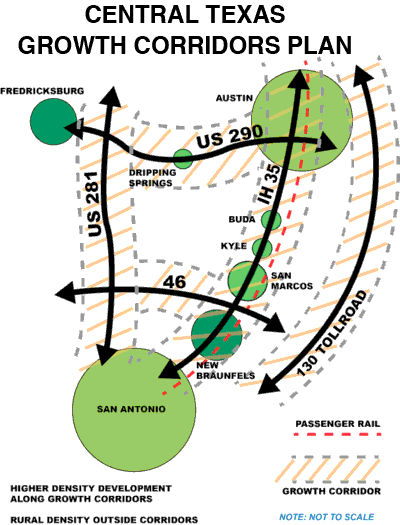|
Development - Residential and Commercial
Development in the Texas Hill Country is always a controversial topic. Some say we should close the gate and stop new development. Others say growth is inevitable and we must learn to accept and embrace new development. Central Texas is certainly on an upward growth curve with population in Hays County growing from 65,614 in 1990 to 157,107 in 2010. Projections for Hays County say we will exceed a population of 628,000 in 2040.
So what are the implications for western Hays County, where we still enjoy open space, flowing creeks and rivers (except during drought), and little urban congestion? Will development spread all over Hays County or will growth be concentrated in areas where roads, water, and sewer are available?
CARD advocates a plan for Hays County that recommends "growth corridors" along IH 35, US 290, US 281, and SH 46 leaving central Hays County/northern Comal County with rural development density, open space, and minimal demand for infrastructure (For details, see Transportation).

Conceptual map of the growth corridors
|
In 2009, the Hays County Commissioners Court adopted new development regulations for western Hays County that set a standard of minimum lot size of six acres for new subdivisions over 50 acres served with private wells. However, where subdivisions are served by public water supply companies, lot sizes can be reduced to 1.5 acre with a septic system, and further reduced with public water and public sewer.
A major controlling factor for development in western Hays County is the availability of drinking water. For decades the underlying Trinity Aquifer provided an abundant supply of high quality drinking water pumped from depths of 300’to 600’. Now with more than 6,500 private wells and 17 water supply companies pumping from the aquifer, portions of the aquifer are going dry and groundwater levels are constantly dropping, especially during drought times. The local Hays Trinity Groundwater Conservation District, which regulates pumping for water supply companies, has approved a 50% increase in groundwater pumping over the coming 50 year planning cycle. This will result in a 19’ average drop in the groundwater levels resulting in many private wells, area springs and creeks, and rivers going dry. (For details, see Water).
Like water availability, "carrying capacity" is a factor to consider in relation to development. A beam spanning between two supports has a certain carrying capacity. When the beam is loaded beyond its capacity, it breaks. Likewise, land has a carrying capacity. In its natural state, land has limited capacity to provide for dense development. With the addition of water lines, sewer systems, high capacity roads, power lines, and drainage systems, the carrying capacity of land can be increased, up to a point, but at great expense and ongoing operational cost. When such structural changes are made to the land, the character of the land is forever altered. Compare the land use in rural areas to land in cities and also compare the systems necessary to maintain the two different development standards.
Western Hays County has major choices to make in the near future. Shall we seek a land development pattern that reflects a rural lifestyle with low impact development? At the other extreme shall we pursue higher density development that requires importation of expensive outside water, construction of big roads, and the inevitable higher taxes?
CARD believes that the interior of Hays County should seek the lower impact development that will allow its citizens to continue to enjoy open spaces and flowing streams. This choice will require diligence from involved citizens who will work to protect this area’s rural character.
|

